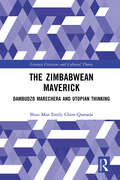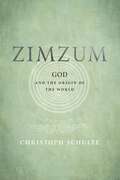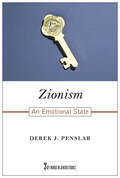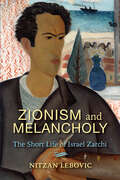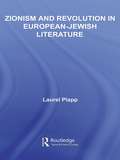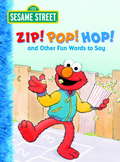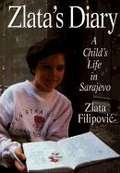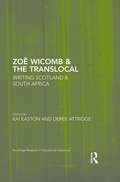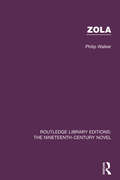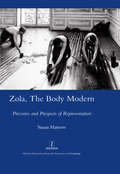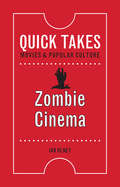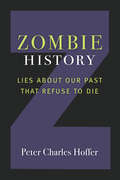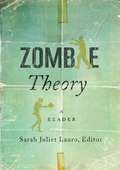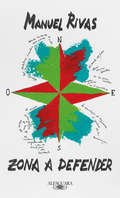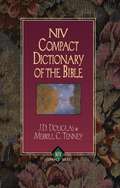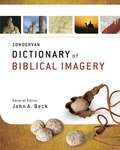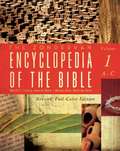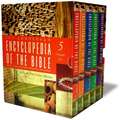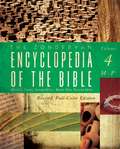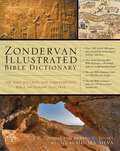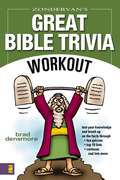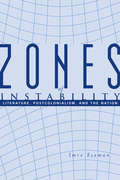- Table View
- List View
The Zimbabwean Maverick: Dambudzo Marechera and Utopian Thinking (Literary Criticism and Cultural Theory)
by Shun Man CHOW-QUESADAThis book seeks to unfold the complexity within the works of Dambudzo Marechera and presents scholars and readers with a way of reading his works in light of utopian thinking. Writing during a traumatic transitional period in Zimbabwe’s history, Marechera witnessed the upheavals caused by different parties battling for power in the nation. Aware of the fact that all institutionalized narratives – whether they originated from the colonial governance of the UK, Ian Smith’s white minority regime, or Zimbabwe’s revolutionary parties – appeal to visions of a utopian society but reveal themselves to be fiction, Marechera imagined a unique utopia. For Marechera, utopia is not a static entity but a moment of perpetual change. He rethinks utopia by phrasing it as an ongoing event that ceaselessly contests institutionalized narratives of the postcolonial self and its relationship to society. Marechera writes towards a vision of an alternative future for the country. Yet, it is a vision that does not constitute a fully rounded sense of utopia. Being cautious about the world and the operation of power upon the people, rather than imposing his own utopian ideals, Marechera chooses instead to destabilize the narrative constitution of the self in relation to society in order to turn towards a truly radical utopian thinking that empowers the individual.
Zimzum: God and the Origin of the World (Jewish Culture and Contexts)
by Christoph SchulteThe Hebrew word zimzum originally means “contraction,” “withdrawal,” “retreat,” “limitation,” and “concentration.” In Kabbalah, zimzum is a term for God’s self-limitation, done before creating the world to create the world. Jewish mystic Isaac Luria coined this term in Galilee in the sixteenth century, positing that the God who was “Ein-Sof,” unlimited and omnipresent before creation, must concentrate himself in the zimzum and withdraw in order to make room for the creation of the world in God’s own center. At the same time, God also limits his infinite omnipotence to allow the finite world to arise. Without the zimzum there is no creation, making zimzum one of the basic concepts of Judaism.The Lurianic doctrine of the zimzum has been considered an intellectual showpiece of the Kabbalah and of Jewish philosophy. The teaching of the zimzum has appeared in the Kabbalistic literature across Central and Eastern Europe, perhaps most famously in Hasidic literature up to the present day and in philosopher and historian Gershom Scholem’s epoch-making research on Jewish mysticism. The Zimzum has fascinated Jewish and Christian theologians, philosophers, and writers like no other Kabbalistic teaching. This can be seen across the philosophy and cultural history of the twentieth century as it gained prominence among such diverse authors and artists as Franz Rosenzweig, Hans Jonas, Isaac Bashevis Singer, Harold Bloom, Barnett Newman, and Anselm Kiefer.This book follows the traces of the zimzum across the Jewish and Christian intellectual history of Europe and North America over more than four centuries, where Judaism and Christianity, theosophy and philosophy, divine and human, mysticism and literature, Kabbalah and the arts encounter, mix, and cross-fertilize the interpretations and appropriations of this doctrine of God’s self-entanglement and limitation.
Zionism: An Emotional State (Key Words in Jewish Studies)
by Derek J. PenslarEmotion lies at the heart of all national movements, and Zionism is no exception. For those who identify as Zionist, the word connotes liberation and redemption, uniqueness and vulnerability. Yet for many, Zionism is a source of distaste if not disgust, and those who reject it are no less passionate than those who embrace it. The power of such emotions helps explain why a word originally associated with territorial aspiration has survived so many years after the establishment of the Israeli state. Zionism: An Emotional State expertly demonstrates how the energy propelling the Zionist project originates from bundles of feeling whose elements have varied in volume, intensity, and durability across space and time. Beginning with an original typology of Zionism and a new take on its relationship to colonialism, Penslar then examines the emotions that have shaped Zionist sensibilities and practices over the course of the movement’s history. The resulting portrait of Zionism reconfigures how we understand Jewish identity amidst continuing debates on the role of nationalism in the modern world.
Zionism and Melancholy: The Short Life of Israel Zarchi (New Jewish Philosophy and Thought)
by Nitzan Lebovic“Lebovic reveals a great deal about the work of Zarchi and the melancholic mindset of an entire generation of contemporary Israelis . . . Highly recommended.” —ChoiceNitzan Lebovic claims that political melancholy is the defining trait of a generation of Israelis born between the 1960s and 1990s. This cohort came of age during wars, occupation and intifada, cultural conflict, and the failure of the Oslo Accords. The atmosphere of militarism and conservative state politics left little room for democratic opposition or dissent.Lebovic and others depict the failure to respond not only as a result of institutional pressure but as the effect of a long-lasting “left-wing melancholy.” In order to understand its grip on Israeli society, Lebovic turns to the novels and short stories of Israel Zarchi. For him, Zarchi aptly describes the gap between the utopian hope present in Zionism since its early days and the melancholic reality of the present. Through personal engagement with Zarchi, Lebovic develops a philosophy of melancholy and shows how it pervades Israeli society.
Zionism and Revolution in European-Jewish Literature (Literary Criticism and Cultural Theory)
by Laurel PlappZionism and Revolution in European-Jewish Literature examines twentieth-century Jewish writing that challenges imperialist ventures and calls for solidarity with the colonized, most notably the Arabs of Palestine and Africans in the Americas. Since Edward Said defined orientalism in 1978 as a Western image of the Islamic world that has justified domination, critics have considered the Jewish people to be complicit with orientalism because of the Zionist movement. However, the Jews of Europe have themselves been caught between East and West —both marginalized as the "Orientals" of Europe and connected to the Middle East through their own political and cultural ties. As a result, European-Jewish writers have had to negotiate the problematic confluence of antisemitic and orientalist discourse. Laurel Plapp traces this trend in utopic visions of Jewish-Muslim relations that criticized the early Zionist movement; in post-Holocaust depictions of coalition between Jews and African slaves in the Caribbean revolutions; and finally, in explorations of diasporic, transnational Jewish identity after the founding of Israel. Above all, Plapp proposes that Jewish studies and postcolonial studies have much in common by identifying ways in which Jewish writers have allied themselves with colonized and exilic peoples throughout the world.
Zip! Pop! Hop! and Other Fun Words to Say (Big Bird's Favorites Board Books)
by Michaela Muntean David PrebennaElmo and his friends have lots of fun saying oodles of words with interesting sounds--and which sometimes feel a little funny in the mouth--such as pop, zip, hopscotch, growl, snip, gurgle, squiggly, ticktock, and lots more. There are giggles galore for babies and toddlers on every single page!From the Board edition.
Zlata's Diary: A Child's Life in Sarajevo
by Zlata Filipovic Christina Pribichevich-ZoricThis journal entry represents Zlata's insightful writing and the translators skill: "Thursday, October 14, 1993 Dear Mimmy, Those lunatics up in the hills must have read what I wrote about the shooting yesterday. They want to show me that they're still around. They went SHOOTING today. Shells fell around the market-place, and we don't know how Grandma and Grand-dad are. Poor things. These lunatics haven't just stolen from us our childhood, they've stolen from my grandparents and other old people a peaceful old age. They're not letting them live out the rest of their lives in peace. They had to ruin that too. I didn't have classes or music school today. They sent us home, so I'll spend the whole day at home reading, playing the piano, spending some time with Nejra and Haris. I was supposed to go to Mirna's today, but they spoiled that for me. I didn't tell you, Mimmy, that you're about to go out into the world. You're going to be published abroad. I allowed it, so you could tell the world what I wrote to you. I wrote to you about the war, about myself and Sarajevo in the war, and the world wants to know about it. I wrote what I felt, saw and heard, and now people outside of Sarajevo are going to know it. Have a good journey into the world. Your Zlata" A fine book for a book report. Teens sensitive to cruelty will want to share this diary with parents. This was a horrific piece of history.
Zoë Wicomb & the Translocal: Writing Scotland & South Africa (Routledge Research in Postcolonial Literatures)
by Kai Easton Derek AttridgeThis is the first book on the fiction of Zoë Wicomb, a writer long at the forefront of the South African canon and whose international stature was firmly secured with the award of an inaugural Windham Campbell prize at Yale in 2013. It brings together interdisciplinary essays from the UK, USA, South Africa, and Australia, demonstrating Wicomb’s importance as a novelist, short-story writer, and critic. The central focus of the volume is the translocal, a term that navigates the complex and shifting relations between disparate localities, respecting the situatedness of each locality within its immediate geopolitical context, while investigating the connections and contrasts that operate between them. In Wicomb’s case, her work stems from a dual allegiance to two localities, both in her fiction as in her life: South Africa’s Western Cape and the west of Scotland. In tracking the relations, contemporary and historical, between these sites, her fiction reveals a consistent interest in and interrogation of home and belonging, space and place; it also offers telling insights into questions of race and gender. The historical processes of colonization and migration that have produced translocal connections of this kind are central to postcolonial studies, to which this book makes a significant contribution. Exploring the visual and cartographical, and extending debates on the transnational and cosmopolitan that are currently taking place across disciplines, including literary studies, geography, history, politics, and anthropology, the collection covers the range of Wicomb’s work. It also features an unanthologised essay by Wicomb herself, an interview, and a suite of photographs by Sophia Klaase, whose images of Namaqualand inspired Wicomb’s most recent novel, October.
Zola (Routledge Library Editions: The Nineteenth-Century Novel #38)
by Phillip WalkerIn the novels of Emile Zola, the pain and horror of working class life was pushed into the drawing rooms of polite society. Zola set out to shock and to question the assumptions of fiction and of comfortable, settled lives. The impact of his writing was far wider than France, and his attacks on the pillars of society gave him an international reputation. First published in 1985, this biography of Zola does much more than simply describe Zola as a writer, and his literary impact. It brings together the many strands of Zola’s life and creates an impression of a remarkable, if often exasperating individualist. This book will be of interest to those studying the works of Emile Zola and more broadly nineteenth-century and French literature.
Zola, The Body Modern: Pressures and Prospects of Representation
by Susan HarrowEmile Zola's reputation as a landmark European novelist is undisputed. His monumental achievement, the novel cycle Les Rougon-Macquart: Histoire sociale et naturelle d'une famille sous le Second Empire (1871-1893), fixed his status as a major writer in the naturalist tradition. Is there any more to be said? Susan Harrow answers boldly in the affirmative, challenging the commonplace view that Zola's writing is predictable, prolix and transparent (what Barthes called 'readerly', for which read 'tedious'). Harrow exposes the modernist and postmodernist strategies which surface in the Rougon-Macquart novels, and reveals Zola's innovatory representation of the body captured here at work, at war, at play, at rest, and in arresting abstraction. Informed by critical thought from Barthes and Deleuze to Michel de Certeau and Anthony Giddens, Zola, the Body Modern offers a model for how we can revitalize our understanding of the canonical nineteenth-century European novel, and learn to travel more flexibly between parameters of century, style and aesthetics.
Zombie Cinema
by Ian OlneyIt’s official: the zombie apocalypse is here. The living dead have been lurking in popular culture since the 1930s, but they have never been as ubiquitous or as widely-embraced as they are today.Zombie Cinema is a lively and accessible introduction to this massively popular genre. Presenting a historical overview of zombie appearances in cinema and on television, Ian Olney also considers why, more than any other horror movie monster, zombies have captured the imagination of twenty-first-century audiences. Surveying the landmarks of zombie film and TV, from White Zombie to The Walking Dead, the book also offers unique insight into why zombies have gone global, spreading well beyond the borders of American and European cinema to turn up in films from countries as far-flung as Cuba, India, Japan, New Zealand, and Nigeria. Both fun and thought-provoking, Zombie Cinema will give readers a new perspective on our ravenous hunger for the living dead.
Zombie History: Lies About Our Past that Refuse to Die
by Peter Charles HofferFake history is not a harmless mistake of fact or interpretation. It is a mistake that conceals prejudice; a mistake that discriminates against certain kinds of people; a mistake held despite a preponderance of evidence; a mistake that harms us. Fake history is like the Zombies we see in mass media, for the fake fact, like the fictional Zombie, lives by turning real events and people into monstrous perversions of fact and interpretation. Its pervasiveness reveals that prejudice remains its chief appeal to those who believe it. Its effect is insidious, because we cannot or will not destroy those mischievous lies. Zombie history is almost impossible to kill. Some Zombie history was and is political, a genre of what Hannah Arendt called “organizational lying” about the past. Its makers designed the Zombie to create a basis in the false past for particular discriminatory policies. Other history Zombies are cultural. They encapsulate and empower prejudice and stereotyping. Still other popular history Zombies do not look disfigured, but like Zombies walk among us without our realizing how devastating their impact can be. Zombie History argues that, whatever their purpose, whatever the venue in which they appear, history Zombies undermine the very foundations of disinterested study of the past.
Zombie Theory: A Reader
by Sarah Juliet LauroZombies first shuffled across movie screens in 1932 in the low-budget Hollywood film White Zombie and were reimagined as undead flesh-eaters in George A. Romero’s The Night of the Living Dead almost four decades later. Today, zombies are omnipresent in global popular culture, from video games and top-rated cable shows in the United States to comic books and other visual art forms to low-budget films from Cuba and the Philippines. The zombie’s ability to embody a variety of cultural anxieties—ecological disaster, social and economic collapse, political extremism—has ensured its continued relevance and legibility, and has precipitated an unprecedented deluge of international scholarship. Zombie studies manifested across academic disciplines in the humanities but also beyond, spreading into sociology, economics, computer science, mathematics, and even epidemiology. Zombie Theory collects the best interdisciplinary zombie scholarship from around the world. Essays portray the zombie not as a singular cultural figure or myth but show how the undead represent larger issues: the belief in an afterlife, fears of contagion and technology, the effect of capitalism and commodification, racial exclusion and oppression, dehumanization. As presented here, zombies are not simple metaphors; rather, they emerge as a critical mode for theoretical work. With its diverse disciplinary and methodological approaches, Zombie Theory thinks through what the walking undead reveal about our relationships to the world and to each other.Contributors: Fred Botting, Kingston U; Samuel Byrnand, U of Canberra; Gerry Canavan, Marquette U; Jeffrey Jerome Cohen, George Washington U; Jean Comaroff, Harvard U; John Comaroff, Harvard U; Edward P. Comentale, Indiana U; Anna Mae Duane, U of Connecticut; Karen Embry, Portland Community College; Barry Keith Grant, Brock U; Edward Green, Roosevelt U; Lars Bang Larsen; Travis Linnemann, Eastern Kentucky U; Elizabeth McAlister, Wesleyan U; Shaka McGlotten, Purchase College-SUNY; David McNally, York U; Tayla Nyong’o, Yale U; Simon Orpana, U of Alberta; Steven Shaviro, Wayne State U; Ola Sigurdson, U of Gothenburg; Jon Stratton, U of South Australia; Eugene Thacker, The New School; Sherryl Vint, U of California Riverside; Priscilla Wald, Duke U; Tyler Wall, Eastern Kentucky U; Jen Webb, U of Canberra; Jeffrey Andrew Weinstock, Central Michigan U.
Zona a defender
by Manuel RivasUn libro comprometido sobre el mundo en el que vivimos y el que debemos dejar en herencia. La literatura de Manuel Rivas vuelve a intervenir en el mundo. En un mundo centrado en el rendimiento económico e industrial, este libro propone una perspectiva esperanzada y literaria sobre la necesidad de impulsar un cambio de significado de palabras como «sociedad», «naturaleza», «poder», «individuo», «cultura» o «creación», y de encontrar un espacio de reflexión sobre lo que nos falta. En cada página brilla el compromiso social y ecológico del autor, su sensibilidad, su ironía y la belleza de su prosa. En el mundo deberían multiplicarse las zonas a defender. Aquello que debería estar más defendido es lo más vulnerable. Lo más inseguro. ¡Mayday! Defiendo una internacional de las conciencias indóciles que ya no dejará dormir a las conciencias tranquilas.Defiendo la posibilidad. El primer paso es decir: «Es posible». Defiendo la posibilidad de ser humanos. Defiendo una república de iguales, una ruptura con la corrupción. Defiendo un nuevo contrato de la sociedad con la naturaleza. Defiendo una austeridad fértil, una abundancia creativa. Defiendo una soledad solidaria. Defiendo un nuevo lenguaje imaginativo contra la política del daño. Defiendo un humor amoratado, sabotear el dogmatismo con ironía. Defiendo un feminismo que emancipe a las mujeres y libere a los hombres del «histerismo masculino». Defiendo descolonizar la imaginación, contar historias para sostener el cielo. Defiendo una nueva lucha por la libertad. Defiendo la prohibición en la posesión de armas, con una excepción: la risa. Defiendo el acuerdo entre generaciones. Defiendo el arte de la escucha, defiendo ver lo que no está «bien visto». Defiendo la democracia afectiva. Defiendo los libros demasiado largos, las películas demasiado lentas. Defiendo el arte de caer. Defiendo pensar lo impensable. Hago boxeo de sombras. Camino por el horizonte enfermo. El pesimismo rebelde va de la mano de una esperanza indócil. MANUEL RIVAS La crítica ha dicho:«Manuel Rivas ha escrito un libro contundente: Contra todo esto. Hecho a toque de corneta, para la rebelión. ¿Vamos hacia la utopía o hacia la distopía? ¿Qué se puede cambiar en este mundo cochambroso? Para leer en traje (civil) de campaña.»Luisgé Martín «Escrito con un lirismo que hace que cada página se deguste dulcemente [y] en sintonía con una indignación que cada vez vemos más representada en pensadores, Manuel Rivas transporta al lector a un mundo mejor, un mundo posible. Un ensayo necesario especialmente en estos tiempos en los que la pandemia nos ha distanciado aún más de nuestros mayores, pero que a la vez ha servido para evidenciar queel sistema en el que vivimos no es ni justo, ni eficaz.»Ahora Qué Leo, La Sexta «Una señal de socorro en forma de libro donde se expone sin resguardo y su única arma defensiva es la palabra. [...] A Manuel Rivas el parque le sienta bien y es testigo del gran narrador oral que es. Te hipnotiza.»Marta de la Calzada, Telva «Rivas es un clásico indiscutible.»The Scotsman «Manuel Rivas es un narrador importante porque es sensible y tiene un oído increíble que, en su ficción, está aliado con una gran integridad.»John Berger «Rivas desvela el alma de los espacios, lo que guardan o contienen en tanto que expresión de emblema del carácter de un pueblo.»Ana Rodríguez Fischer, Babelia «Un autor que sabe cómo introducir la poesía no solo en sus frases, sino también en su manera de ver el mundo.»Raphaëlle Rérolle, Le Monde «Rivas nunca pierde la fe en la capacidad humana para superar la más
Zondervan Bible Dictionary
by J. D. Douglas C. MerrillWho were the Pharisees? What did Samson and John the Baptist have in common? Does an altar really have "horns?" Turn to the Zondervan Bible Dictionary and find out. It has the answers to these and hundreds of other questions you're likely to wonder about as you read the Bible. Condensed from the New International Bible Dictionary, this unique volume actually offers three books in one: • A Dictionary—for easy-to-find, practical information on thousands of topics • A Topical Index—for detailed study of nearly 150 larger topics, listing all articles in the dictionary that relate to a given topic • A Survey—providing an introductory overview of the Bible, biblical history, and biblical culture. Concise, readable, and informative, the Zondervan Bible Dictionary is ideal for use at home, in study groups, and in schools. It will help you clear up the who, what, where, why, and how of the Bible so you can better appreciate the depth of its wisdom and its relevance for you today.
Zondervan Dictionary of Biblical Imagery
by John A. BeckLearning the meaning and significance of biblical images will revolutionize your grasp of the Bible as a whole. Scripture is packed with symbolic imagery and metaphors: looms, donkeys, water cisterns, grapes, sackcloth—all carry symbolic or emotional weight that sharpens the broader picture of the passage.The biblical authors used their reality to enhance the impact of their message on the audience around them, and the language they used is rich with meaning. The words might be familiar today, but the cultural connotations of things like manna, millstones, or myrrh might be missed by contemporary Christians and might cause us to lose the fullest significance of the Bible passage.The Zondervan Dictionary of Biblical Imagery surveys the use and connotations of familiar images in the Bible to illustrate the intricate and subtle ways they're put to work in the text. The types of entries include:Cultural artifacts from the biblical world (such as arrow or sandal)Components of natural history (such as fox or fig tree)Named places (such as Mount Sinai or Nazareth)Components of Israel's physical geography (such as mountain or wilderness)Each entry describes an image's characteristics, appearance, intended use, and cultural connotations, as well as the rhetorical impact of its use in the Bible. As you read, you'll begin to understand things like why Jesus called for us to become the salt of the earth, why dew was a controversial topic in Bible times, and why a roof might be mentioned to draw attention to a violation of expected norms.With accessible, well-illustrated entries and numerous black & white visuals, The Zondervan Dictionary of Biblical Imagery is an inspiring portal into the biblical world for any student of the Bible.
The Zondervan Encyclopedia of the Bible, Volume 1: Revised Full-Color Edition
by Merrill C. Tenney Moisés SilvaRevised edition. Volume 1 of 5. The Zondervan Encyclopedia of the Bible has been a classic Bible study resource for more than thirty years. Now thoroughly revised, this new five-volume edition provides up-to-date entries based on the latest scholarship. Beautiful full-color pictures supplement the text, which includes many new articles in addition to thorough updates and improvements of existing topics. Different viewpoints of scholarship permit a well-rounded perspective on significant issues relating to doctrines, themes, and biblical interpretation. The goal remains the same: to provide pastors, teachers, students, and devoted Bible readers with a comprehensive and reliable library of information. • More than 5,000 pages of vital information on Bible lands and people • More than 7,500 articles alphabetically arranged for easy reference • Hundreds of colorful maps, illustrations, charts, and graphs • Scholarly articles ranging across the entire spectrum of theological and biblical topics, backed by the most current body of archaeological research • Over 250 contributors from around the world • Introductions to each book of the Bible • Bibliographies and helpful cross-references
The Zondervan Encyclopedia of the Bible, Volume 2: Revised Full-Color Edition
by Moisés Silva Merrill C. TenneyRevised edition. Volume 2 of 5. The Zondervan Encyclopedia of the Bible has been a classic Bible study resource for more than thirty years. Now thoroughly revised, this new five-volume edition provides up-to-date entries based on the latest scholarship. Beautiful full-color pictures supplement the text, which includes new articles in addition to thorough updates and improvements of existing topics. Different viewpoints of scholarship permit a wellrounded perspective on significant issues relating to doctrines, themes, and biblical interpretation. The goal remains the same: to provide pastors, teachers, students, and devoted Bible readers a comprehensive and reliable library of information. • More than 5,000 pages of vital information on Bible lands and people • More than 7,500 articles alphabetically arranged for easy reference • Hundreds of full-color and black-and-white illustrations, charts, and graphs • 32 pages of full-color maps and hundreds of black-and-white outline maps for ready reference • Scholarly articles ranging across the entire spectrum of theological and biblical topics, backed by the most current body of archaeological research • 238 contributors from around the world
The Zondervan Encyclopedia of the Bible, Volume 3: Revised Full-Color Edition
by Moisés Silva Merrill C. TenneyRevised edition. Volume 3 of 5. The Zondervan Encyclopedia of the Bible has been a classic Bible study resource for more than thirty years. Now thoroughly revised, this new five-volume edition provides up-to-date entries based on the latest scholarship. Beautiful full-color pictures supplement the text, which includes new articles in addition to thorough updates and improvements of existing topics. Different viewpoints of scholarship permit a wellrounded perspective on significant issues relating to doctrines, themes, and biblical interpretation. The goal remains the same: to provide pastors, teachers, students, and devoted Bible readers a comprehensive and reliable library of information. • More than 5,000 pages of vital information on Bible lands and people • More than 7,500 articles alphabetically arranged for easy reference • Hundreds of full-color and black-and-white illustrations, charts, and graphs • 32 pages of full-color maps and hundreds of black-and-white outline maps for ready reference • Scholarly articles ranging across the entire spectrum of theological and biblical topics, backed by the most current body of archaeological research • 238 contributors from around the world
The Zondervan Encyclopedia of the Bible, Volume 4: Revised Full-Color Edition
by Merrill C. Tenney Moisés SilvaRevised edition. Volume 4 of 5. The Zondervan Encyclopedia of the Bible has been a classic Bible study resource for more than thirty years. Now thoroughly revised, this new five-volume edition provides up-to-date entries based on the latest scholarship. Beautiful full-color pictures supplement the text, which includes new articles in addition to thorough updates and improvements of existing topics. Different viewpoints of scholarship permit a wellrounded perspective on significant issues relating to doctrines, themes, and biblical interpretation. The goal remains the same: to provide pastors, teachers, students, and devoted Bible readers a comprehensive and reliable library of information. • More than 5,000 pages of vital information on Bible lands and people • More than 7,500 articles alphabetically arranged for easy reference • Hundreds of full-color and black-and-white illustrations, charts, and graphs • 32 pages of full-color maps and hundreds of black-and-white outline maps for ready reference • Scholarly articles ranging across the entire spectrum of theological and biblical topics, backed by the most current body of archaeological research • 238 contributors from around the world
The Zondervan Encyclopedia of the Bible, Volume 5: Revised Full-Color Edition
by Moisés Silva Merrill C. TenneyRevised edition. Volume 5 of 5. The Zondervan Encyclopedia of the Bible has been a classic Bible study resource for more than thirty years. Now thoroughly revised, this new five-volume edition provides up-to-date entries based on the latest scholarship. Beautiful full-color pictures supplement the text, which includes new articles in addition to thorough updates and improvements of existing topics. Different viewpoints of scholarship permit a wellrounded perspective on significant issues relating to doctrines, themes, and biblical interpretation. The goal remains the same: to provide pastors, teachers, students, and devoted Bible readers a comprehensive and reliable library of information. • More than 5,000 pages of vital information on Bible lands and people • More than 7,500 articles alphabetically arranged for easy reference • Hundreds of full-color and black-and-white illustrations, charts, and graphs • 32 pages of full-color maps and hundreds of black-and-white outline maps for ready reference • Scholarly articles ranging across the entire spectrum of theological and biblical topics, backed by the most current body of archaeological research • 238 contributors from around the world
Zondervan Illustrated Bible Dictionary
by J. D. Douglas Merrill C. TenneyA visually stimulating journey for anyone interested in learning more about the world of the Bible.The Zondervan Illustrated Bible Dictionary offers a wealth of insight into the historical, chronological, archaeological, geographical, social, theological, and biographical aspects of the Bible. Through the articles, sidebars, charts, maps, and full-color images included in this volume, the text of the Old and New Testaments will come alive for you as never before. As a condensation of the Zondervan Pictorial Encyclopedia of the Bible, the information contained within this reference work is solid and biblically sound. The material is based completely on the NIV and cross-referenced to the King James Version.Features include:Over 7,200 entries with up-to-date scholarship, archaeological findings, and more75 full-color maps created with new mapping technologiesOver 500 full-color photographs, charts, and illustrationsUnderstanding the Bible can be difficult. The Zondervan Illustrated Bible Dictionary will help you make sense of the Bible's context, people, places, and objects so you can better understand and apply the scripture. Ideal for pastors, Sunday school teachers, students, and general Bible readers.
Zondervan's Great Bible Trivia Workout
by Brad DensmoreBuild Brain Mass While Toning Your Methuselah Muscles Think the Bible is boring? Think again! The Great Bible Trivia Workout will delight and amuse you with a fun collection of trivia covering the entire Bible. Shape up your knowledge of Old and New Testament people, places, and things with multiple-choice quizzes, top-ten lists, true/false tests, and even some Bible-based ditties written to favorite tunes. Brad Densmore offers a true challenge of Bible knowledge with a dose of humor along the way, giving you all new Aha! moments such as these: • "Ouch! Painful and/or Unusual ways to Die": Sisera bit the dust after an encounter with the business end of a tent peg. • "Whatever Floats Your Boat:" Noah was 600 years old at the time of the flood, true or false? • "Top Ten Old Testament Stocks": including MicahSoft and General Ecclesiastes • What do Tamar, Absalom, and the Shulammite woman have in common? They were all noted for their good looks! Ready for your workout? Go for it! You haven't had this much fun since you hid a mouse in that stuffy Sunday school teacher's desk.
Zones of Instability: Literature, Postcolonialism, and the Nation
by Imre SzemanAttempts by writers and intellectuals in former colonies to create unique national cultures are often thwarted by a context of global modernity, which discourages particularity and uniqueness. In describing unstable social and political cultures, such "third-world intellectuals" often find themselves torn between the competing literary requirements of the "local" culture of the colony and the cosmopolitan, "world" culture introduced by Western civilization.In Zones of Instability, Imre Szeman examines the complex relationship between literature and politics by exploring the production of nationalist literature in the former British empire. Taking as his case studies the regions of the British Caribbean, Nigeria, and Canada, Szeman analyzes the work of authors for whom the idea of the"nation" and literature are inexorably entwined, such as Chinua Achebe, Wole Soyinka, C.L.R. James, Frantz Fanon, and V.S. Naipaul. Szeman focuses on literature created in the two decades after World War II, decades in which the future prospects for many colonies went from extreme political optimism to extreme political disappointment. He finds that the "nation" can be read as that space in which literature is thought to be able to conjoin two things that history has separated—the writer and the people.
